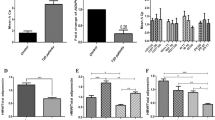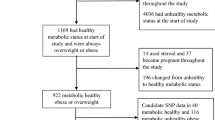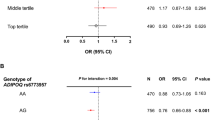Abstract
Results concerning the association of adiponectin gene polymorphisms (single-nucleotide polymorphisms, SNPs) with obesity, type 2 diabetes (T2DM), metabolic disorders and insulin resistance have not lead to definite conclusions. The aim of our study was to investigate a possible association between the −11391G>A and −11377C>G SNPs of adiponectin gene and measure of insulin sensitivity evaluated by the hyperinsulinemic-euglycemic clamp in a group of ‘uncomplicated’ obese subjects (with no associated comorbidities) (n=99, mean age 35 years) with a history of obesity lasting at least 10 years. The study of uncomplicated obese subjects, free of possible confounding factors that could interfere with insulin sensitivity, such as pharmacological treatment, provides a good model to assess insulin sensitivity per se. We observed that subjects homozygous for the G allele at locus −11391 had lower M (mg/kg min)/fat-free mass (FFM) index and adiponectin levels compared to subjects with GA+AA genotypes (P=0.002 and P=0.03, respectively) and subjects carrying the −11377G variant had lower M (mg/kg min)/FFM index and adiponectin levels compared to noncarriers (P=0.003 and P=0.03, respectively). Our results imply that the two promoter SNPs, −11391G>A and −11377C>G, of the adiponectin gene are associated with a reduced insulin sensitivity evaluated by hyperinsulinemic-euglycemic clamp in obese subjects.
This is a preview of subscription content, access via your institution
Access options
Similar content being viewed by others
References
Ahima RS, Flier JS . Adipose tissue as an endocrine organ. Trends Endocrinol Metab 2000; 11: 327–332.
Pajvani UB, Du X, Combs TP, Berg AH, Rajala MW, Schulthess T et al. Structure-function studies of the adipocyte-secreted hormone Acrp30/adiponectin. Implications for metabolic regulation and bioactivity. J Biol Chem 2003; 278: 9073–9085.
Yamauchi T, Kamon J, Ito Y, Tsuchida A, Yokomizo T, Kita S et al. Cloning of adiponectin receptors that mediate antidiabetic metabolic effects. Nature 2003; 423: 762–769.
Menzaghi C, Ercolino T, Di Paola R, Berg AH, Warram JH, Scherer PE et al. A haplotype at the adiponectin locus is associated with obesity and other features of the insulin resistance syndrome. Diabetes 2002; 51: 2306–2312.
Hara K, Boutin P, Mori Y, Tobe K, Dina C, Yasuda K et al. Genetic variation in the gene encoding adiponectin is associated with an increased risk of type 2 diabetes in the Japanese population. Diabetes 2002; 51: 536–540.
Stumvoll M, Tschritter O, Fritsche A, Staiger H, Renn W, Weisser M et al. Association of the T-G polymorphism in adiponectin (exon 2) with obesity and insulin sensitivity: interaction with family history of type 2 diabetes. Diabetes 2002; 51: 37–41.
Hu FB, Doria A, Li T, Meigs JB, Liu S, Memisoglu A et al. Genetic variation at the adiponectin locus and risk of type 2 diabetes in women. Diabetes 2004; 53: 209–213.
Gu HF, Abulaiti A, Ostenson CG, Humphreys K, Wahlestedt C, Brookes AJ et al. Single nucleotide polymorphisms in the proximal promoter region of the adiponectin (APM1) gene are associated with type 2 diabetes in Swedish caucasians. Diabetes 2004; 53: S31–S35.
Vozarova de Courten B, Hanson RL, Funahashi T, Lindsay RS, Matsuzawa Y, Tanaka S et al. Common Polymorphisms in the Adiponectin Gene ACDC Are Not Associated With Diabetes in Pima Indians. Diabetes 2005; 54: 284–289.
Vasseur F, Helbecque N, Dina C, Lobbens S, Delannoy V, Gaget S et al. Single-nucleotide polymorphism haplotypes in the both proximal promoter and exon 3 of the APM1 gene modulate adipocyte-secreted adiponectin hormone levels and contribute to the genetic risk for type 2 diabetes in French Caucasians. Hum Mol Genet 2002; 21: 2607–2614.
DeFronzo RA, Tobin JD, Andres R . Glucose clamp technique: a method for quantifying insulin secretion and resistance. Am J Physiol 1979; 237: E214–E223.
Iacobellis G, Ribaudo MC, Zappaterreno A, Iannucci VC, Leonetti F . Prevalence of uncomplicated obesity in an Italian obese population. Obes Res 2005; 13: 1116–1122.
Natali A, Toschi E, Camastra S, Gastaldelli A, Groop L, Ferrannini E . Determinants of postabsorptive endogenous glucose output in non-diabetic subjects. European Group for the Study of Insulin Resistance (EGIR). Diabetologia 2000; 43: 1266–1272.
Lukasky HC, Johnson PE, Bolonchuk WW, Lykken GI . Assessment of fat free mass using bioelectrical impedance measurements of human body. Am J Clin Nutr 1985; 41: 810–817.
Friedewald WT, Levy RJ, Fredrickson DS . Estimation of the concentration of low-density-lipoprotein cholesterol in plasma without use of the preparative ultracentrifuge. Clin Chem 1972; 18: 499–502.
Gorden P, Lesniak MA, Hendricks CM, Roth J . ‘Big’ growth hormone components from human plasma: decreased reactivity demonstrated by radioreceptor assay. Science 1973; 182: 829–831.
Berg AH, Combs TP, Du X, Brownlee M, Scherer PE . The adipocyte-secreted protein Acrp30 enhances hepatic insulin action. Nat Med 2001; 7: 947–953.
Ryo M, Nakamura T, Kihara S, Kumada M, Shibazaki S, Takahashi M et al. Adiponectin as a biomarker of the metabolic syndrome. Circ J 2004; 68: 975–981.
Schaffler A, Langmann T, Palitzsch KD, Scholmerich J, Schmitz G . Identification and characterization of the human adipocyte apM-1 promoter. Biochim Biophys Acta 1998; 20: 187–197.
Lihn AS, Pedersen SB, Richelsen B . Adiponectin action, regulation and association to insulin sensitivity. Obes Rev 2005; 6: 13–21.
Bouatia-Naji N, Meyre D, Lobbens S, Seron K, Fumeron F, Balkau B et al. ACDC/adiponectin polymorphisms are associated with severe childhood and adult obesity. Diabetes 2006; 55: 545–550.
Matthews DR, Hosker JP, Rudenski AS, Naylor BA, Treacher DF, Turner RC . Homeostasis model assessment: insulin resistance and beta-cell function from fasting plasma glucose and insulin concentrations in man. Diabetologia 1985; 28: 412–419.
Acknowledgements
This work has been supported in part by a grant of the Ministry of Health (ICS 030.6/RF00-49) and by a grant of Ministry of University and Research (MIUR 2003 2003061834_004).
Author information
Authors and Affiliations
Corresponding author
Rights and permissions
About this article
Cite this article
Buzzetti, R., Petrone, A., Zavarella, S. et al. The glucose clamp reveals an association between adiponectin gene polymorphisms and insulin sensitivity in obese subjects. Int J Obes 31, 424–428 (2007). https://doi.org/10.1038/sj.ijo.0803419
Received:
Revised:
Accepted:
Published:
Issue Date:
DOI: https://doi.org/10.1038/sj.ijo.0803419
Keywords
This article is cited by
-
Genomic analysis to screen potential genes and mutations in children with non-syndromic early onset severe obesity: a multicentre study in Turkey
Molecular Biology Reports (2022)
-
Insulin Resistance Associated Genes and miRNAs
Applied Biochemistry and Biotechnology (2014)
-
The rs266729 single-nucleotide polymorphism in the adiponectin gene shows association with gestational diabetes
Archives of Gynecology and Obstetrics (2014)
-
ADIPOQ Polymorphisms, Monounsaturated Fatty Acids, and Obesity Risk: The GOLDN Study
Obesity (2009)
-
Variants of the adiponectin gene and type 2 diabetes in a Polish population
Acta Diabetologica (2009)



